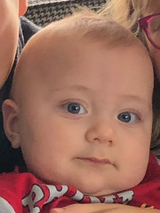Prenatal Diagnosis and Monitoring of Arteriovenous Malformation: Idris' Story
Prenatal Diagnosis and Monitoring of Arteriovenous Malformation: Idris' Story
In the Spring of 2015, PBS aired Twice Born, a miniseries that gave an inside look at the Garbose Family Special Delivery Unit at Children’s Hospital of Philadelphia (CHOP). When Sandrine saw the series, she was struck by the high level of care the team at CHOP provided, including breakthrough surgeries before birth. She never imagined that just a few years later, she would be among the thousands of families who have turned to CHOP for help and hope for their child before birth.
In late 2017, during a 20-week ultrasound at a hospital near her home in a New Jersey suburb just outside of Manhattan, Sandrine learned there was bleeding in her unborn child’s brain. The OB-GYN referred Sandrine, already a mother of two, to a fetal imaging specialist in upstate New York, about 1½ hour from her home, to get a clearer diagnosis.
The fetal imaging specialist was able to clarify that the bleeding was in the cerebellum, but couldn’t tell Sandrine what it meant for her child’s future. When Sandrine told her OB the results, he couldn’t give her any more information either. He suggested she contact the Center for Fetal Diagnosis and Treatment (CFDT) at Children’s Hospital of Philadelphia.
“He said if there’s one place that can figure out what is going on, it is this hospital,” she recalls. Sandrine remembered the Twice Born series and, after researching the hospital online, she knew it was where she needed to go and called to schedule an appointment.
Treating each patient like the only patient
When Sandrine arrived at CHOP for a full-day evaluation at the Center for Fetal Diagnosis and Treatment, she was taken aback by the hospital’s size.
What to Expect at Your First Visit
“I work in Manhattan, so I’m used to big things. But CHOP is humongous,” she says. She was surprised by how at home she felt despite the hospital’s size. “You really feel like you are the only patient. It’s like a family. They held my hand through the whole process. It was an amazing feeling.”
For Sandrine, that feeling of family and support was especially important because her own family still lives in France, where she grew up.
After a number of imaging studies, including a high-resolution fetal ultrasound and fetal MRI, Sandrine met with a coordinated care team, including a fetal radiologist, maternal-fetal medicine specialist, fetal therapy coordinator, and Daniel Licht, MD, a pediatric neurologist. Dr. Licht has specialty training in stroke, critical care and fetal neurologic disorders, and is internationally recognized for his research in brain injury in newborn infants. He confirmed that there was a vascular lesion in the baby’s right cerebellar hemisphere and talked to Sandrine about possible outcomes.
“He is amazing,” says Sandrine, of Dr. Licht. “What I liked was he was able to say, ‘This is what I know, this is what I think, and this is what we are going to do.’ He gave me this reassurance. ‘Yes, there are some unknowns, but this is the path and we are going to take it together.’”
The plan was for Sandrine to return to CHOP every two weeks for monitoring and then perform a scheduled c-section in the Special Delivery Unit (SDU), the first birth facility in a children’s hospital specifically designed for healthy mothers carrying babies with known birth defects. Results from an MRI after birth would determine if surgery was needed.
Prenatal monitoring, delivery and follow-up of arteriovenous malformation
Over the course of the next few months, Sandrine’s children — ages 10 and 5 — occasionally accompanied her on her visits to CHOP for monitoring. During the visits, Child Life specialists would play games with the children and help explain why their mom was at the hospital in an age-appropriate way. They also prepared the children to meet their new sibling in CHOP’s Harriet and Ronald Lassin Newborn/Infant Intensive Care Unit (N/IICU) after birth.
Fortunately, the bleeding on the brain remained stable for the rest of the pregnancy. Baby boy Idris was born according to plan in the SDU.
“It’s a very humbling place,” Sandrine says, of the SDU. “And the nurses in the N/IICU were fantastic. It’s hard as a mother, because there’s nothing you can do to make your child better. You have to give all the power and control to someone else. But they take care of your kid and they’re smiling. They have hard days, but their spirits are still up. They are amazing.”

Four days after Idris was born, he underwent an MRI. Results from the imaging suggested that the lesion was a thrombosed arteriovenous malformation, but that his brain wasn’t bleeding anymore. Cerebellar arteriovenous malformations like the one Idris had are quite uncommon, so it's hard to know what his overall long-term outcome will be. Dr. Licht suspects Idris’s condition was a result of PHACE syndrome, where one half of the cerebellum fails to develop for unknown reasons (probably a vascular injury that happens very early in pregnancy).
“The cognitive outcomes in PHACE syndrome are quite good,” says Licht.
Idris returned to CHOP for repeat MRIs at three months and six months of age. He’ll now return for follow-up every year to monitor for any disabilities due to the bleeding that occurred before birth, but for now, all looks good. His cerebellum is a normal size.
“So far so good,” says Sandrine. “He’s like a normal baby, with a little extra attitude. He knows what he wants.”
She’s grateful for the care her whole family continues to receive at CHOP.
“The problem didn’t disappear and the fear of what was going on didn’t disappear, but I was reassured and feel like we are in the best place we can be,” says Sandrine. “It makes it so much less worse.”